Client-Server Routing with WebSharper

This article is part of F# Advent. Thanks to Sergey Tihon for organizing!
The main advantage of using a single language for a full-stack project (be it in JavaScript/TypeScript, or better, F# 😃 ) is to have common abstractions shared between server and client-side code. This makes making updates to full-stack project much safer and quicker. WebSharper's philosophy is to enable full-stack F#/C# projects that take advantage of this.
Today we are looking at how to share a sitemap and router (mapping between URLs and locations in the site) between client and server. We will be able to:
- Generate links from site locations (Endpoint values)
- Handle certain link navigations (URL changes) on the client without reloading the page, while reloading from server when we enter another part of the site
So routing duties are split between the server and client, meanwhile both sides are able to link to any page on the site safely. This is a compromise between a many-page site and a single-page application which can be useful where speed of navigation is preferred in some page navigations and full page reload for up-to date information or server-side processing in others.
Our demo project is a rudimentary blog engine, that has a Home page with the full list of articles, Article pages for each entry for reading, and an Edit page for editing a selected article or a creating a new one. The sitemap is represented by this type:
type EndPoint =
| [<EndPoint "/">] Home
| [<EndPoint "/article">] Article of id: int
| [<EndPoint "/edit">] Edit of id: int
Navigation between Home and individual articles don't reload the page, while entering/exiting Edit pages do.
Splitting between these lines can be centralized with an active pattern:
let (|ReadPage|EditPage|) e =
match e with
| Home
| Article _ -> ReadPage
| Edit _ -> EditPage
Setup
As this sample uses some easy persistence by writing/reading .txt files in an /articles folder, there is no online demo.
To check out the sample project, run git clone https://github.com/Jand42/MiniBlog then dotnet run from the MiniBlog folder.
Then open http://localhost:5000/

How WebSharper creates routers
If you have and F# union EndPoint type as above, you can create a router instance with let siteRouter = Router.Infer<EndPoint>() that uses the union type's annotations.
We can reuse this to guide the both server-side and client-side parsing of URLs and link generation in a uniform way.
Let's look at first what the server's doing with it:
[<Website>]
let Main =
Sitelet.New siteRouter (fun ctx endpoint ->
match endpoint with
| ReadPage ->
Templating.Main ctx endpoint "MiniBlog" [
div [] [client <@ Client.ReadPage endpoint @>]
]
| EditPage ->
Templating.Main ctx endpoint "Edit article" [
div [] [client <@ Client.EditPage endpoint @>]
]
)
If we encounter a read-only page, we set up the client by passing along our parsed endpoint value, same for an edit page.
The client <@ ... @> helper means: this is content to be generated in JavaScript, server just returns a placeholder and browser does the rest.
Arguments can be passed along and they are auto-serialized.
We also see we are creating a Sitelet object, which is essentially a router and a rendering function paired together in a type-safe abstraction.
Setting up client-side routing
In client-side code (to be transpiled to JavaScript), this is where the magic happens:
let ReadPage endpoint =
let endpointVar = Var.Create endpoint
siteRouter
|> Router.Filter (
function
| Routing.ReadPage -> true
| _ -> false
)
|> Router.InstallInto endpointVar Home
For the ReadPage handler, we only want to handle certain pages, so we filter for it, then install the router as an two-way binding between the URL and a reactive variable.
Then we can tie rendering our page by mapping from this Var, calling the server asynchronously for the content we need in simple records.
This is the part rendering the Home page, containing full list of entries, using the templating engine to define our exact visuals in Html:
endpointVar.View
|> Doc.BindView (
function
| Home ->
async {
let! articles = Server.GetArticles()
return
articles
|> Seq.map (fun a ->
Templates.MainTemplate.Article()
.Title(a.Title)
.Text(createContent a.Text)
.ReadArticleLink(siteRouter.Link (Article a.Id))
.EditArticleLink(siteRouter.Link (Edit a.Id))
.Doc()
)
|> Doc.Concat
}
|> Doc.Async
Take a look at the sample project to see how Rpc functions in the Server module work, it's not a robust solution for this demo, just reading/writing .txt files and keeping an in-memory cache of them too.
Note how we can fill in links generated by the router, and we don't have to worry if the link is handled on the client side or it is let to fall through to go to server for a page reload.
Thank you for reading!
Feel free to discuss on Gitter
Happy New Year!
Read more from
Can’t find what you were looking for? Drop us a line.

